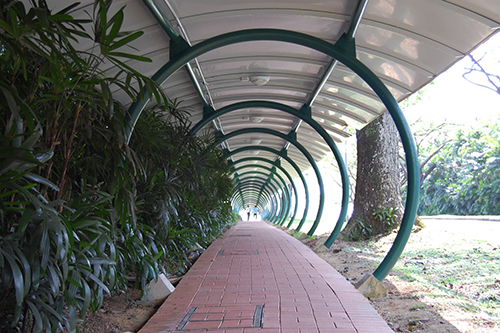Vancouver is a city challenged with a climatic contradiction. Hemmed in between mountains and ocean, the city is fortunate to be home to one of the most moderate climates in Canada. It also has to contend with some of the wettest weather conditions, where average annual precipitation rates in Vancouver float around 1450 millimeters. Under these circumstances, it’s not abnormal for the city to experience upwards of twenty consecutive days of rain in wintertime.
The result of these prolonged stretches of rainfall has been the adoption by Vancouverites of a reoccurring “hibernation” pattern, which generally occurs between the months of October and March. Consequently, regardless of mild temperatures, Vancouver has earned the reputation of a city that “shuts down” to avoid the rain during the winter months. This leads takes its toll on public spaces and public life – factors that are also tied to everything from health and wellbeing, to community involvement, to nightlife, to everyday interpersonal interactions.
In response to these issues, the VPSN will be featuring a series of articles that will aim to explore rain-friendly public space initiatives from around the world. The intent of this project is to inspire Vancouver to adopt some of these rain-proofing policies at home, thus extending public life in Vancouver to continue year-round.
This first article will launch the series by taking a look at Singapore, a city that combats upwards of 2340 millimeters of precipitation per year with highly effective rain-proofing strategies.
Singapore demonstrates several forms of infrastructure that allow outdoor activities to remain accessible throughout their rainy season. Perhaps most notably are an intriguing system of canopies, such as the one pictured here (albeit in good weather) – at historic Clarke Quay.
The canopy structure covers the roadway, creating an arcade-like enclosure that shelters visitors from the rain. These structures are suspended high above the space below in order to maintain the feeling of being outdoors. Clarke Quay is Singapore’s hot spot for bars, restaurants and nightlife, comparable to Vancouver’s Granville Street. By covering the Quay in this fashion, the city has managed to enable public life to thrive outdoors even during their monsoon season. Following this precedent, what if Granville Street received a similar canopy treatment in wintertime? Could this encourage Vancouverites to remain more social and engaged throughout the rainy winter months, or solving the need to stay in, or hop from indoor space to indoor space to avoid getting wet?
Another challenge that we see in Vancouver relates to larger campus-type spaces – such as those found at universities like SFU or UBC, or at hospitals (like VGH). These campuses are large – in some cases even comparable to a small city – and they are connected by a network of pedestrian paths (themselves a very positive feature). At the same time, the rainy season can make these paths less inviting than they could be – especially for students or workers that have to move back and forth between multiple buildings.
An example from Singapore suggests one solution: the covered walkway. As pictured here, Nanyang Technological University combats rain on its campus by providing covered walkways between buildings and along sidewalks. Additionally, the university was careful to construct overhangs that run along the sides of buildings to provide further coverage. This takes the typical Vancouver building-edge canopy (that four foot plastic rim that lines many of our buildings) and takes it to the next level.
Here’s one image of the campus by blogger olinsigapore:
So what about our city? How can we extend our public life throughout the rainy season?
Features like these are just a couple of examples of rain-proofing initiatives from another city that Vancouver could potentially adopt or modify in enhancing its own weather-related strategies. As noted, the two ideas showcased in this article have proven to be effective in maintaining public life in Singapore, extending it throughout the year.






